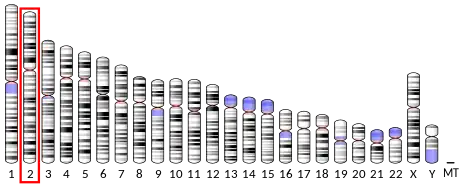D2HGDH
D-2-hydroxyglutarate dehydrogenase, mitochondrial is an enzyme that in humans is encoded by the D2HGDH gene.[5][6][7]
| D2HGDH | |||||||||||||||||||||||||||||||||||||||||||||||||||
|---|---|---|---|---|---|---|---|---|---|---|---|---|---|---|---|---|---|---|---|---|---|---|---|---|---|---|---|---|---|---|---|---|---|---|---|---|---|---|---|---|---|---|---|---|---|---|---|---|---|---|---|
| Identifiers | |||||||||||||||||||||||||||||||||||||||||||||||||||
| Aliases | D2HGDH, D2HGD, D-2-hydroxyglutarate dehydrogenase | ||||||||||||||||||||||||||||||||||||||||||||||||||
| External IDs | OMIM: 609186 MGI: 2138209 HomoloGene: 5534 GeneCards: D2HGDH | ||||||||||||||||||||||||||||||||||||||||||||||||||
| |||||||||||||||||||||||||||||||||||||||||||||||||||
| |||||||||||||||||||||||||||||||||||||||||||||||||||
| |||||||||||||||||||||||||||||||||||||||||||||||||||
| |||||||||||||||||||||||||||||||||||||||||||||||||||
| |||||||||||||||||||||||||||||||||||||||||||||||||||
| Wikidata | |||||||||||||||||||||||||||||||||||||||||||||||||||
| |||||||||||||||||||||||||||||||||||||||||||||||||||
This gene encodes D-2hydroxyglutarate dehydrogenase is a mitochondrial enzyme belonging to the FAD-binding oxidoreductase/transferase type 4 family. This enzyme, which is most active in liver and kidney but also active in heart and brain, converts D-2-hydroxyglutarate to 2-ketoglutarate. Mutations in this gene are present in D-2-hydroxyglutaric aciduria, a rare recessive neurometabolic disorder causing developmental delay, epilepsy, hypotonia, and dysmorphic features.[7]
See also
References
- GRCh38: Ensembl release 89: ENSG00000180902 - Ensembl, May 2017
- GRCm38: Ensembl release 89: ENSMUSG00000073609 - Ensembl, May 2017
- "Human PubMed Reference:". National Center for Biotechnology Information, U.S. National Library of Medicine.
- "Mouse PubMed Reference:". National Center for Biotechnology Information, U.S. National Library of Medicine.
- Achouri Y, Noel G, Vertommen D, Rider MH, Veiga-Da-Cunha M, Van Schaftingen E (Jun 2004). "Identification of a dehydrogenase acting on D-2-hydroxyglutarate". Biochem J. 381 (Pt 1): 35–42. doi:10.1042/BJ20031933. PMC 1133759. PMID 15070399.
- Struys EA, Salomons GS, Achouri Y, Van Schaftingen E, Grosso S, Craigen WJ, Verhoeven NM, Jakobs C (Jan 2005). "Mutations in the D-2-hydroxyglutarate dehydrogenase gene cause D-2-hydroxyglutaric aciduria". Am J Hum Genet. 76 (2): 358–60. doi:10.1086/427890. PMC 1196381. PMID 15609246.
- "Entrez Gene: D2HGDH D-2-hydroxyglutarate dehydrogenase".
Further reading
- Gibson KM, Craigen W, Herman GE, Jakobs C (1995). "D-2-hydroxyglutaric aciduria in a newborn with neurological abnormalities: a new neurometabolic disorder?". J. Inherit. Metab. Dis. 16 (3): 497–500. doi:10.1007/BF00711664. PMID 7609436. S2CID 31099476.
- Bonaldo MF, Lennon G, Soares MB (1997). "Normalization and subtraction: two approaches to facilitate gene discovery". Genome Res. 6 (9): 791–806. doi:10.1101/gr.6.9.791. PMID 8889548.
- Strausberg RL, Feingold EA, Grouse LH, et al. (2003). "Generation and initial analysis of more than 15,000 full-length human and mouse cDNA sequences". Proc. Natl. Acad. Sci. U.S.A. 99 (26): 16899–903. Bibcode:2002PNAS...9916899M. doi:10.1073/pnas.242603899. PMC 139241. PMID 12477932.
- Ota T, Suzuki Y, Nishikawa T, et al. (2004). "Complete sequencing and characterization of 21,243 full-length human cDNAs". Nat. Genet. 36 (1): 40–5. doi:10.1038/ng1285. PMID 14702039.
- Gerhard DS, Wagner L, Feingold EA, et al. (2004). "The status, quality, and expansion of the NIH full-length cDNA project: the Mammalian Gene Collection (MGC)". Genome Res. 14 (10B): 2121–7. doi:10.1101/gr.2596504. PMC 528928. PMID 15489334.
- Hillier LW, Graves TA, Fulton RS, et al. (2005). "Generation and annotation of the DNA sequences of human chromosomes 2 and 4". Nature. 434 (7034): 724–31. Bibcode:2005Natur.434..724H. doi:10.1038/nature03466. PMID 15815621.
- Struys EA, Korman SH, Salomons GS, et al. (2005). "Mutations in phenotypically mild D-2-hydroxyglutaric aciduria". Ann. Neurol. 58 (4): 626–30. doi:10.1002/ana.20559. PMID 16037974. S2CID 45926378.
- Misra VK, Struys EA, O'brien W, et al. (2006). "Phenotypic heterogeneity in the presentation of D-2-hydroxyglutaric aciduria in monozygotic twins". Mol. Genet. Metab. 86 (1–2): 200–5. doi:10.1016/j.ymgme.2005.06.005. PMID 16081310.
- Kimura K, Wakamatsu A, Suzuki Y, et al. (2006). "Diversification of transcriptional modulation: large-scale identification and characterization of putative alternative promoters of human genes". Genome Res. 16 (1): 55–65. doi:10.1101/gr.4039406. PMC 1356129. PMID 16344560.
- Struys EA, Verhoeven NM, Salomons GS, et al. (2006). "D-2-hydroxyglutaric aciduria in three patients with proven SSADH deficiency: genetic coincidence or a related biochemical epiphenomenon?". Mol. Genet. Metab. 88 (1): 53–7. doi:10.1016/j.ymgme.2005.12.002. PMID 16442322.
- Ewing RM, Chu P, Elisma F, et al. (2007). "Large-scale mapping of human protein-protein interactions by mass spectrometry". Mol. Syst. Biol. 3 (1): 89. doi:10.1038/msb4100134. PMC 1847948. PMID 17353931.
This article is issued from Wikipedia. The text is licensed under Creative Commons - Attribution - Sharealike. Additional terms may apply for the media files.



